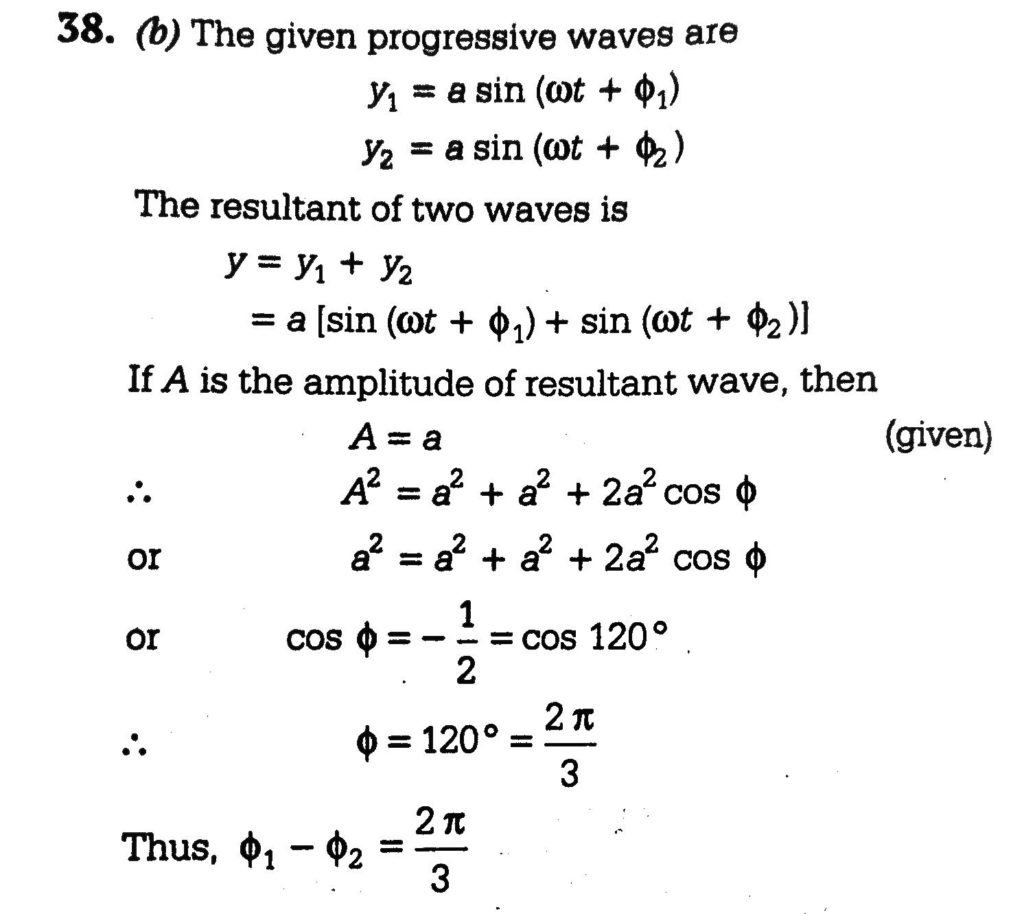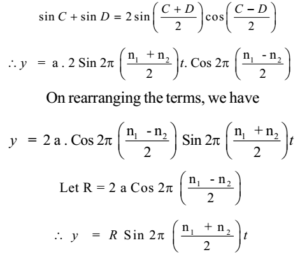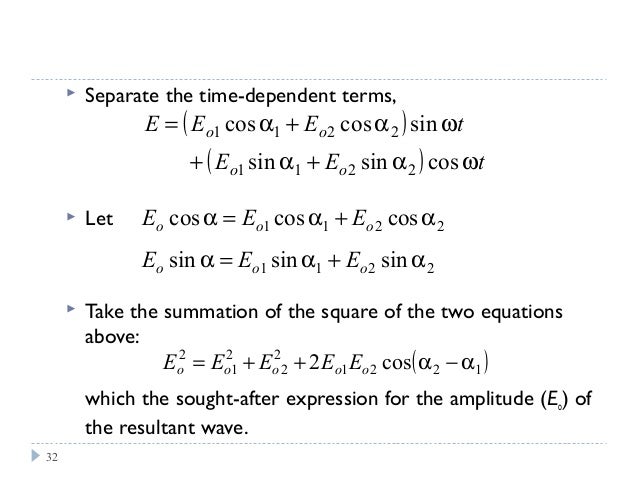Resultant Amplitude Of Two Waves Derivation
Destructive interference occurs when two interfering waves have displacements in opposite directions. Derivation of Interference of Waves.

Two Waves That Add To Give A Resultant With The Same Amplitude Youtube
Then as the intensity is proportional to the amplitude squared the total intensity from the two sources individually is proportional to 2 A 2.

Resultant amplitude of two waves derivation. This is constructive interference. The interference of waves results in the medium taking shape resulting from the net effect of the two individual waves. The two waves are described with the functions y 1 x t A c o s 2 x 1 1 t y 2 x t A c o s 2 x 2 2 t.
The resultant amplitude of two interfering waves is equal to the sum of those two waves displacements at the same location as the resultant waves amplitude. Furthermore this concept is called constructive interference. Any other phase difference results in a wave with the same wave number and angular frequency as the two incident waves but with a phase shift of latex varphi text2 latex and an amplitude equal to latex 2Atextcosvarphi text2.
What is the derivation. How do you superimpose 3 waves. Let the two coherent waves be By principle of superposition the resultant wave is 3where r is the amplitude of resultant wave and is given by 4If both the waves have same amplitude then Intensity of a wave is directly proportional to square of amplitude.
Resultant of two waves -- Different amplitudephase difference Thread starter CricK0es. The resultant wave has an amplitude of zero. Resultant amplitude of 2 waves.
Given a problem of this nature this is what I would think of doing. Close Posted by just now. Phasor method tex E1 4cost tex tex E2 3costfracpi2 tex b By algebraically writing tex E1 4cost- tex tex E2 3cos.
Each wave is a periodic disturbance. Ive come across the relationship for the resultant amplitudes of superposition of 2 waves. The resultant amplitude of the wave we get through the combination of the two interfering waves is equal to the addition of the displacements of those two waves at the same location as the.
Similarly if the meeting of a crest. Resultant amplitude of 2 waves. Resultant amplitude of two waves derivation.
In Physics interference is defined as The phenomenon in which two or more waves superpose to form a resultant wave of greater lower or the same amplitude. Figure 1624 Superposition of two waves with. Any other phase difference results in a wave with the same wave number and angular frequency as the two.
T0 we get A_ res cos0 A_1cos0 A_2cos0- phi implies A_ res A_1 A_2cosphi. Qquad qquad psi_2. The amplitude of resultant wave is given by where a and b are amplitudes of two waves and is the phase differnce.
CBSE Gujarat Board Haryana Board. Therefore intensities of waves are wher p is constant of proportionality. In accordance with the principle of superposition of waves if the meeting of a crest of a wave takes place with the crest of another wave of the same frequency at the same point then the resultant amplitude turns out to be the sum of individual amplitudes.
A_1 2 A_2 2 2A_1A_2costheta My question is can someone tell me where this equation come from. Tags waves interference Jan 10 2017 1 CricK0es. When the two waves have a phase difference of zero the waves are in phase and the resultant wave has the same wave number and angular frequency and an amplitude equal to twice the individual amplitudes part a.
Log in or sign. Given this information how can we find the amplitude of the resultant wave. For the amplitude of the superposition of two waves to have the same amplitude as the original waves their phase difference must be 120o 2pi3 radians Consider the superposition of two sinusoidal waves of identical amplitude psi_0 separated just by a phase shift phi.
Amplitude is the maximum displacement of the wave. When the two waves have a phase difference of zero the waves are in phase and the resultant wave has the same wave number and angular frequency and an amplitude equal to. Start date Jan 10 2017.
Currently only available for. Amplitude of the Resultant Wave produced due to Superposition of two Waves entire Derivation WAVES SUPERPOSITION OF WAVES 12th standard Lecture 4Revised syll. Physics Part II Subject Chosen.
Download books and chapters from book store. The mathematical expressions for the waves psi_1x and psi_2x are. It is easier at first to assume that the amplitudes of the superposing waves are the same A.
Download the PDF Question Papers Free for off line practice. Resultant Amplitude and Intensity of Two waves in Wave Optics for JEE and NEET is the topic of this physics video lesson. If the phase difference is 180 the waves interfere in destructive interference part c.
Hence when the two waves are believed to be in-phase 0 then. Yxt y_1xt y_2x t A_ rescoskx-omega t A_1coskx-omega t A_2coskx-omega t -phi textSetting x0. Homework Statement a Find the resultant of the two waves.
Now from equation 4 or or If then The variation of intenisty of resultant wave. Find the amplitude of the resultant wave produced due to interference of two waves given as y1 A1 sint y2 A2 sint Maharashtra State Board HSC Science General 12th Board Exam. The resultant wave has an amplitude of zero.
Latex Examples are shown in parts b and d.
Two Waves Of The Same Frequency And Same Amplitude Are Reaching A Point Simultaneously What Should Be The Phase Difference Between The Waves So That The Amplitude Of The Resultant Wave Is 2a

Superposition Of Waves Principle Constructive Destructive Interference

Superposition Of Waves Principle Constructive Destructive Interference

Chapter 11 Superposition Of Light Wave When Two Waves

Question Video Identifying The Resultant Of Two Interfering Waves Nagwa

Equation For Two Waves Is Given As Y 1 Asin Omegat Phi 1 Y 2 Asin Omegat Phi 2 If Ampitude And Time Period Of Resultant Wave Does Not Change Then Calculate Phi 1 Phi 2

The Resultant Amplitude When Two Waves Of Two Waves Of Same Frequency But With Youtube
Two Waves Have Equations Sarthaks Econnect Largest Online Education Community

Resultant Amplitude And Intensity Of Two Waves In Wave Optics For Jee And Neet Youtube

9 Two Waves Are Described By The Following Equations Chegg Com

State The Principle Of Superposition Of Waves Write The Expression For The Resultant Amplitude Of A Brainly In

Two Waves Having Equaitons X 1 Asin Omegat Phi 1 X Asin Omega Phi 2 If In The Resultant Wave The Frequency And Amplitude Remain Equal To Those Of Superimposing Waves Then Phase Difference Between Them Is

Q If Two Waves Of Same Frequency And Same Amplitude On Superposition Produce A Resultant Disturbance Of Same Amplitude Physics Waves 12335965 Meritnation Com

Equations Of Two Progressive Waves At A Certain Point In A Medium Are Given By Y1 Asin Wt 1 And Y2 A Sin Wt 2 If Amplitude And Time Period Of Resultant Wave Are Same As

Formation Of Beats Meaning Of Beats Expression For Period And Frequency

What Is The Amplitude Of Resultant Wave When Two Waves Y1 A1sin W T B1 And Y2 A2sin W T B2 Superimpose

If The Two Waves Of The Same Frequency And Same Amplitude On Superposition Youtube
Describe Analytically Phenomenon Of Interference Of Light And Explain Constructive And Destructive Interference Sarthaks Econnect Largest Online Education Community

Post a Comment for "Resultant Amplitude Of Two Waves Derivation"